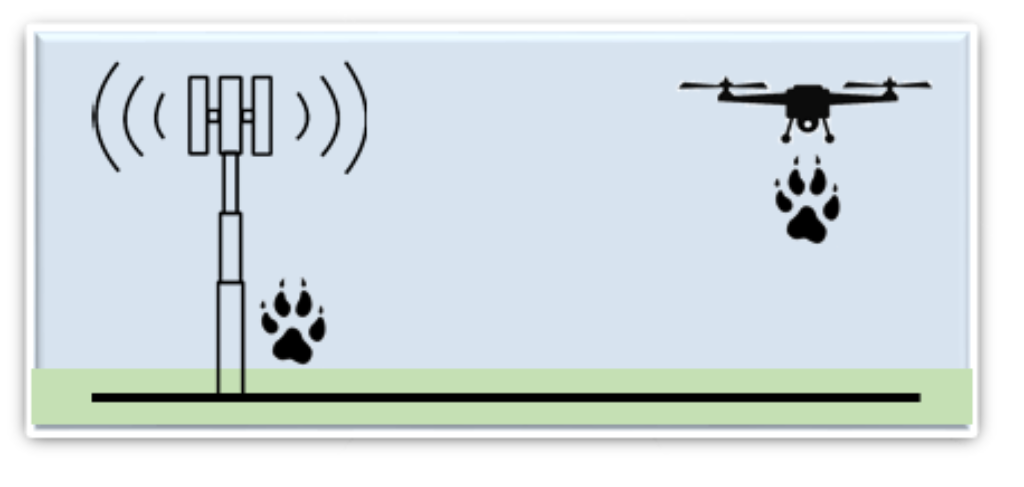
This experimental scenario includes communication between a fixed tower and a drone, as illustrated in the adjacent figure, where both ends carry a PAW. We will initially consider limited mobility for the drone, e.g., the drone may be tethered (power and fiber) to make it available for experimentation that may last several hours or longer. In AERPAW, we are presently using a drone tether from NTP Drone. We consider the limited mobility of the drone, e.g., the experimenter may be primarily interested in channel propagation measurements at different drone altitudes. The horizontal location of the drone may also be changed semi-statically by moving the drone tether to different locations, and short-distance horizontal movements can be possible to the extent that the drone tether allows.
Experiments in this mode can involve those between two or more portable SDRs, as well as the SDRs and other equipment (e.g. RF sensors, base stations, IoT APs). Some example experiments include evaluation of the RF coverage at different drone heights/locations and for different antenna orientations and wideband channel sounding experiments.
RF Coverage Measurement
| [1] Z. Qiu, X. Chu, C. Calvo-Ram´ırez, C. Briso, and X. Yin, “Low altitude UAV air-to-ground channel measurement and modeling in semiurban environments,” Wirel. Commun. Mob. Comput., vol. 2017, 2017. |
| [2] L. Sundqvist, “Cellular controlled drone experiment: Evaluation of network requirements,” G2 Pro gradu, diplomityo, 2015. [Online]. Available: ¨ http://urn.fi/URN:NBN:fi:aalto-201512165670. |
| [3] K. Kainrath, J. Feiner, W. Zugaj, E. Leitgeb, H. Fluehr, and M. Gruber, “Evaluation of data sets for mobile radio signal coverage up to 150 meters above ground,” in Proc. IEEE Int. Conf. on Broadband Communications for Next Generation Networks and Multimedia Applications (CoBCom), 2020, pp. 1–6. |
| [4] A. Al-Hourani, S. Kandeepan, and A. Jamalipour, “Modeling air-to-ground path loss for low altitude platforms in urban environments,” in Proc. IEEE Globecom, Austin, TX, Dec 2014, pp. 2898–2904. |
| [5] M. Batistatos, “LTE ground-to-air measurements for UAV-assisted cellular networks,” IET Conf. Proc., pp. 801 (5 pp.)–801 (5 pp.)(1), Jan. 2018. |
| [6] M. T. Dabiri, H. Safi, S. Parsaeefard, and W. Saad, “Analytical channel models for millimeter-wave UAV networks under hovering fluctuations,” IEEE Trans. Wireless Commun., vol. 19, no. 4, pp. 2868–2883, 2020. |
| [7] J. Chen, D. Raye, W. Khawaja, P. Sinha, and I. Guvenc, “Impact of 3D UWB antenna radiation pattern on air-to-ground drone connectivity,” in Proc. IEEE Veh. Technl. Conf. (VTC), Sep. 2018. |
| [8] M. A. Kishk, A. Bader, and M. Alouini, “On the 3-D placement of airborne base stations using tethered UAVs,” IEEE Trans. Commun., vol. 68, no. 8, pp. 5202–5215, 2020. |
Wideband Channel Sounding
| [1] D. Becker, U. Fiebig, and L. Schalk, “Wideband channel measurements and first findings for low altitude drone-to-drone links in an urban scenario,” in 2020 14th European Conf. on Antennas and Propagation (EuCAP), 2020, pp. 1–5. |
| [2] W. Khwaja, I. Guvenc, and D. W. Matolak, “UWB channel sounding and modeling for UAV air-to-ground propagation channels,” in Proc. IEEE GLOBECOM, Washington, DC, Dec. 2016 |
